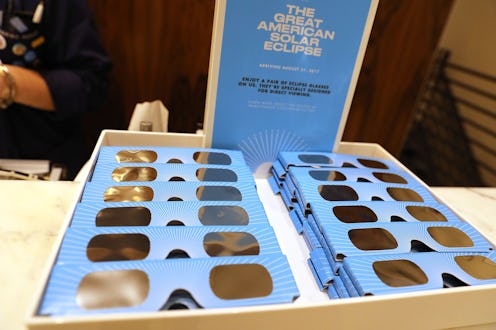Fashion
Where To Get Solar Eclipse Glasses For The 2017 Event

With less than a week to go until the solar eclipse on Aug. 21, 2017, when the moon passes over the face of the sun (in some places, it'll be a total solar eclipse), people are scrambling to get their hands on a pair of eclipse glasses to witness the historic event. Unfortunately, since everyone has pretty much the same idea, the country's in a bit of a crisis — most free and for-purchase pairs have been snapped up.
Even though the solar eclipse has been on the world's calendar for, quite literally, years and years, its imminent arrival is kicking people into gear a little too late. (Not to mention, people who bought counterfeit glasses early on may be getting their refunds from Amazon, but that still leaves them glasses-less.) While many libraries and stores were selling or giving away certified safe pairs, they're becoming increasingly difficult to find no matter where you live.
And, no, looking at the eclipse directly is not an option — NASA warns that staring at the sun even for a few seconds is extremely unsafe and can lead to permanent eye damage (so, really, don't try it).
This doesn't mean you're entirely out of luck, though. Where there's a will, there's a way — and since a total eclipse won't happen again till April 8, 2024, it's worth doing everything you can to experience it (safely). Here are five options to try if you don't have a pair of glasses yet.
1. Find A Viewing Party Near You
If you can play hooky from work or you have the day off, museums, libraries, and even bars around the country are hosting solar eclipse viewing parties, and many of them will have glasses at the event to give out. Obviously, supplies are limited, so it's worth getting to whatever viewing shindig you choose to ensure you can grab a pair before they're gone.
A quick Google searching of "solar eclipse viewing parties in [your city]" should pull up options of where to go (just make sure that they will, in fact, have some glasses to give out). NASA also has a map of official viewing events.
2. Buy Them In Bulk
This is one of the pricier options, but many online retailers are still selling solar eclipse glasses in larger packs of 25 and up. You'll likely have to pay for expedited shipping, but if you've got a group of people who are all stuck in this solar eclipse glasses pickle, you could consider splitting the cost. Of course, make sure you're buying glasses that meet the ISO 12312-2 international safety standard—the American Astronomical Society has a list of 14 companies they've approved, and links to buy from them. (They're also noting which sites are sold out, which is helpful.)
3. DIY An Eclipse-Viewing Contraption
This option takes the most effort, but even though it's old-school, it works. One option is a pinhole projector, and it's pretty simple. You poke a hole in a sheet of paper and project the sun through it to another piece of paper, with your back to the sun. Warby Parker has a handy template you can print (because they're all about your eye health).
If you have a large box, you can also try USA Today's version of a pinhole camera, where you stick your head in a box and view the eclipse projected onto a white sheet of paper, similar to the above method. Here's their guide on how to make one.
4. Keep Calling Around To Local Stores And Libraries
OK, this is a long shot. But if you're really determined to find a pair, hit the phones now to see if locations near you still have glasses on offer. Here's an official map of the libraries that had them, or check in at the retailers that the American Astronomical Society pointed to, including 7-Eleven, Best Buy, Kroger, Lowe's, Toys "R" Us, and Walmart (here's their full list of retailers, although some cities may have additional options). Warby Parker also had them beginning on August 1, but chances are most locations are out. (Worth a shot, though.)
5. Watch It Online
Worst case scenario, NASA will be live-streaming the eclipse starting at 12 p.m. ET, too. (This is a good option if the weather's crap and you can't see anyway.) Here's a list of platforms you can watch it on, including a streaming page, Facebook Live, YouTube, Periscope, and even an app.